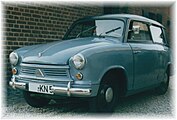Lloyd 400
| Lloyd | |
|---|---|
|
Lloyd LP 400, manufactured in 1955
|
|
| 400 | |
| Sales designation: | LP 400 / LC 400 / LS 400 / LK 400 |
| Production period: | 1953-1957 |
| Class : | Microcar |
| Body versions : | Limousine , convertible sedan , station wagon , panel van |
| Engines: |
Otto engine : 0.4 liters (9.6 kW) |
| Length: | 3355 mm |
| Width: | 1410 mm |
| Height: | 1400 mm |
| Wheelbase : | 2000 mm |
| Empty weight : | 510 kg |
| Previous model | Lloyd 300 |
| successor | Lloyd 600 |
The Lloyd 400 was a small car that Lloyd Motoren Werke GmbH in Bremen built from 1953 to 1957 as the successor to the Lloyd 300 . The 400 in the model name stands for the (rounded) cubic capacity in cm³.
Engine and chassis
Like the engine of the predecessor, the two-cylinder two - stroke engine of the Lloyd 400 with flat- flow carburetor Solex 30 BFRH was installed across the front. The bore was enlarged by 8 mm compared to the Lloyd 300 (bore × stroke = 62 mm × 64 mm); the power increased to 13 HP (9.6 kW) at 3750 rpm and the torque to 28.45 Nm at 2750 rpm. The engine needed a petrol-oil mixture in a ratio of 1:25.
From 1956 there was an "economy version" with a 250 cm² engine for owners of the old class IV driving license. It was offered as the Lloyd 250 .
The cars had a single-disk dry clutch, a non-synchronized three-speed sliding gear with crutch shift, front-wheel drive and rack-and-pinion steering. The front wheels were suspended from two transverse leaf springs, the rear swing axle from semi-elliptical longitudinal leaf springs.
In the first few months, the drum brakes were still operated mechanically by cable pull, as in the predecessor, and hydraulically from March 1953. The mechanically operated handbrake worked on the front wheels.
Frame and body
Like the Lloyd 300, the 400 had a central tubular frame and a platform floor. Initially, he also took over the body made of synthetic leather-covered plywood shells from its predecessor. Only the front of the vehicle was designed a bit more modern. So the nickname "Leukoplastbomber" still applied.
As early as March 1953, the side parts were made of sheet steel; from January 1954 also the bonnet and the rear of the vehicle. From November 1954, the roof was also made of sheet steel.
In addition to the sedan with the additional designation LP , there was a station wagon with the additional designation LS and a panel van ( LK ). From August 1955, a convertible sedan ( LC ) was also offered. The two side doors of all body variants were hinged at the back.
Prices and production figures
The two-door sedan LP 400 was available in 1953 for DM 3,780. By 1955 their price had fallen to DM 3,350. The three-door station wagon LS 400 initially cost DM 3970, -. By 1955, its price had also dropped to DM 3,480. The most expensive model was the LC 400 convertible sedan, which was offered from September 1955 for DM 3,680.
In five years a total of 109,878 Lloyd 400s were built.
source
- Werner Oswald: German Cars 1945–1990 . Volume 4. 1st edition. Motorbuch Verlag, Stuttgart 2001. ISBN 3-613-02131-5 . Pp. 446-447




